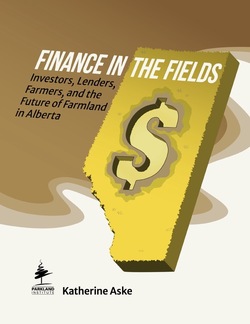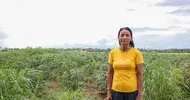Parkland Institute | June 2022
Finance in the fields: Investors, lenders, farmers, and the future of farmland in Alberta
by KATHERINE ASKE
Alberta has over 50 million acres of farmland. What happens on this land? Who owns it? Who can access it? Most of all, why are land relations structured the way they are? And what are the current impacts of these land tenure dynamics and their implications for our future?
The answers to these questions are political, and we urgently need to face them together. This report draws on publicly-funded qualitative research conducted from 2019 to 2020. It seeks to contribute to a vibrant path forward for rural Alberta.
The report draws from interviews with 52 participants — primarily grain and oilseed farmers, but also others such as Agricultural Fieldmen, scholars, and land brokers. It begins by recounting the significant restructuring of the Canadian agricultural sector that has taken place since the neoliberal turn in the 1980s, followed by an analysis of the core research findings showing how and why grain and oilseed farmland tenure is changing, and concludes by making a case for how we ought to make sense of these changes.
The 2007-08 global economic collapse sent investor actors searching for more stable places to store their wealth and watch it accumulate. In this context, investment groups and wealthy individuals reassessed farmland’s potential as an asset class and began buying it up in droves. In the early years of the hype, research was focused on the swaths of land being seized in the Global South, and the resulting upheaval of local populations. However, it is now clear that investors have been buying up farmland in North America as well, and research into the topic is growing in Canada.
The trend of investors buying up farmland is part of a larger phenomenon called ‘financialization,’ through which financial actors, motives, markets, and institutions continue to grow in their power and influence across the economy. This report argues that Alberta’s farmland is becoming financialized — though unevenly and with mixed success — predominantly through: 1) the purchase of farmland by investor actors, and 2) liberalized bank lending policies. These trends contribute to farmland prices rising far beyond the land’s agri-economic value, the rise of tenant farming and rental rates, and changing relationships to and prioritizations on the land. They also contribute to the longstanding concentration and consolidation of the land in the hands of the few who can afford to purchase and rent it — most notably the owners of the largest farms.
High land prices compound with other startup costs and low net incomes to inhibit newcomers to the sector, leading to serious questions about who the next generation of farmers will be. In increasing farmland concentration, high prices erode political equality, thereby also restricting the potential for democratic politics. High land prices amid stagnating net incomes mean farmers are becoming like speculators in their relationship to land, with their fates tied to farmland prices continuing to rise. Tenant farming, an alternative to purchasing land, leaves farmers in precarious economic positions, disconnects them from the long-term health of the land, limits their autonomy, and inhibits them from transitioning to regenerative practices.
The financialization of farmland further cements our large-scale, export-oriented, energy-, capital-, and emission-intensive production model. It is a model that contributes heavily to climate change while simultaneously being vulnerable to its impacts. It is also a model that has indebted and pushed out a great many farmers, and hollowed out rural communities. It threatens community welfare and sovereignty by both syphoning wealth to the financial class and deepening the control and value-capture of big agribusiness.
Land and its affordances are the basis of life itself. The land question in Alberta is thus one for all rural and urban dwellers, landed and landless alike. It requires us to begin by contending with our most profound and foundational shadow as a nation — the ongoing settler-colonial violence toward Indigenous peoples and their dispossession from their territories. An analysis of land tenure patterns reveals the underpinnings of the society standing in and around the fields: what and who it values, who holds power, where these relations began and where they are leading us.
This report concludes by making the case that the financialization of farmland in Alberta will not allow for the kind of alternatives that are required in light of the intertwined crises the agrarian landscape is facing, including the climate crisis, the farm income crisis, and a lack of new entrants to the sector. I argue that we must conceptualize the impacts and implications of the financialization of farmland not from within the confines of the conventional agricultural paradigm, but in light of the need for systemic transformation. We cannot let the complexity of the land question deter us from action, nor let ourselves succumb to narratives suggesting the current path to be inevitable.













